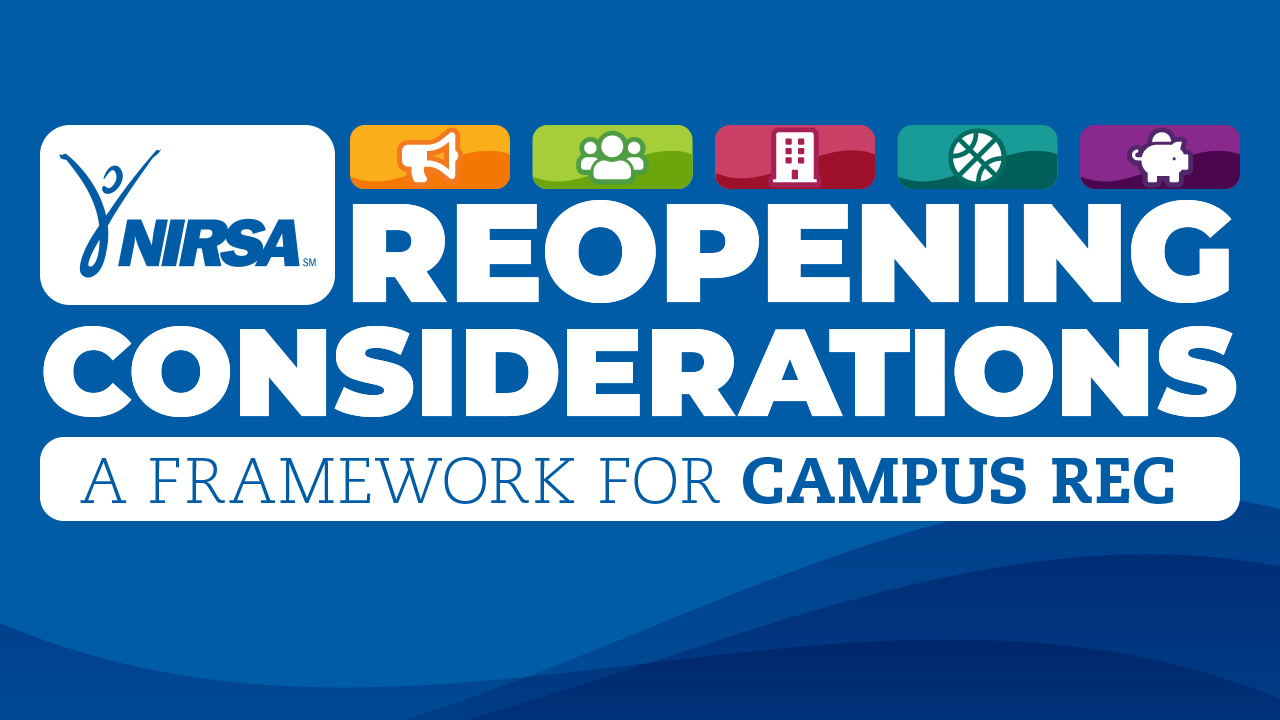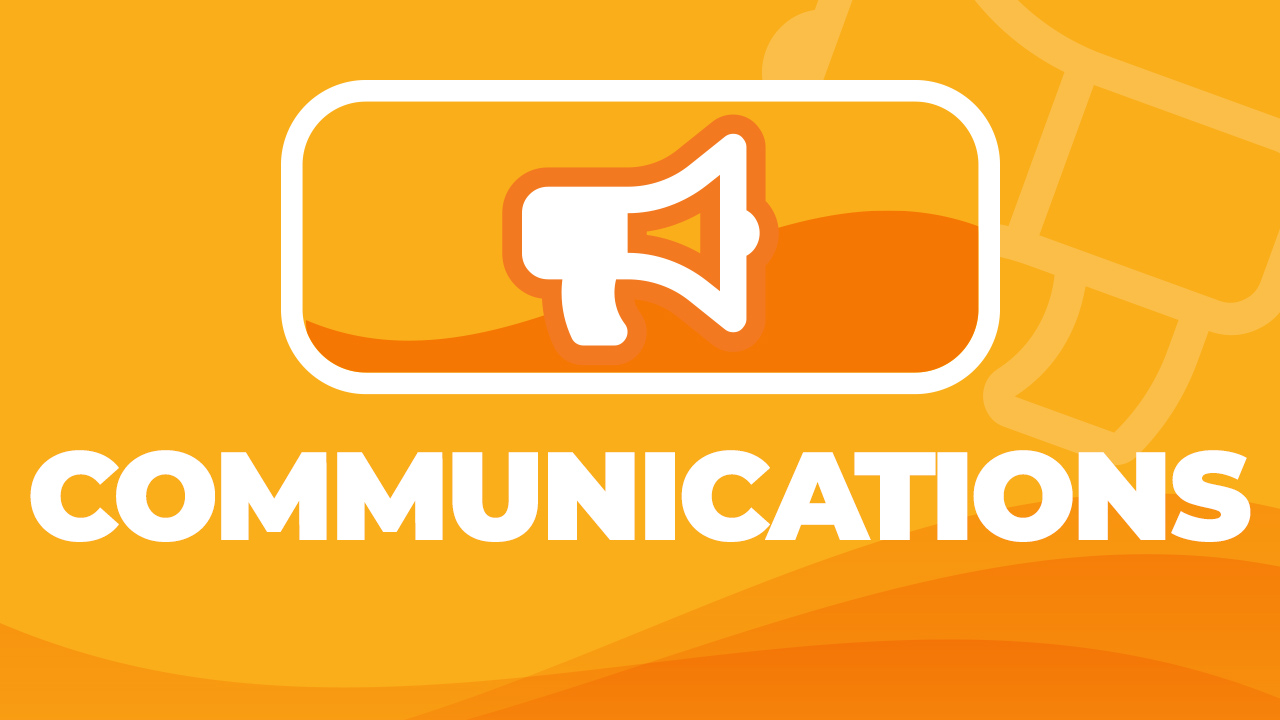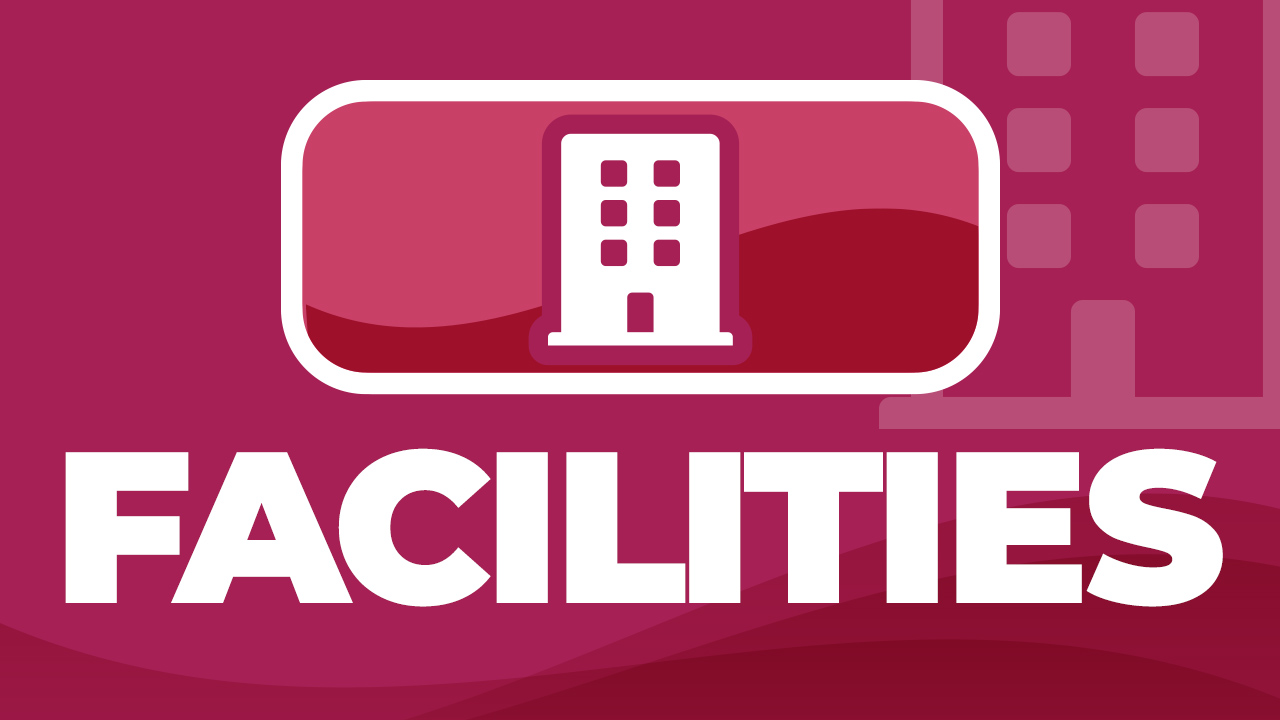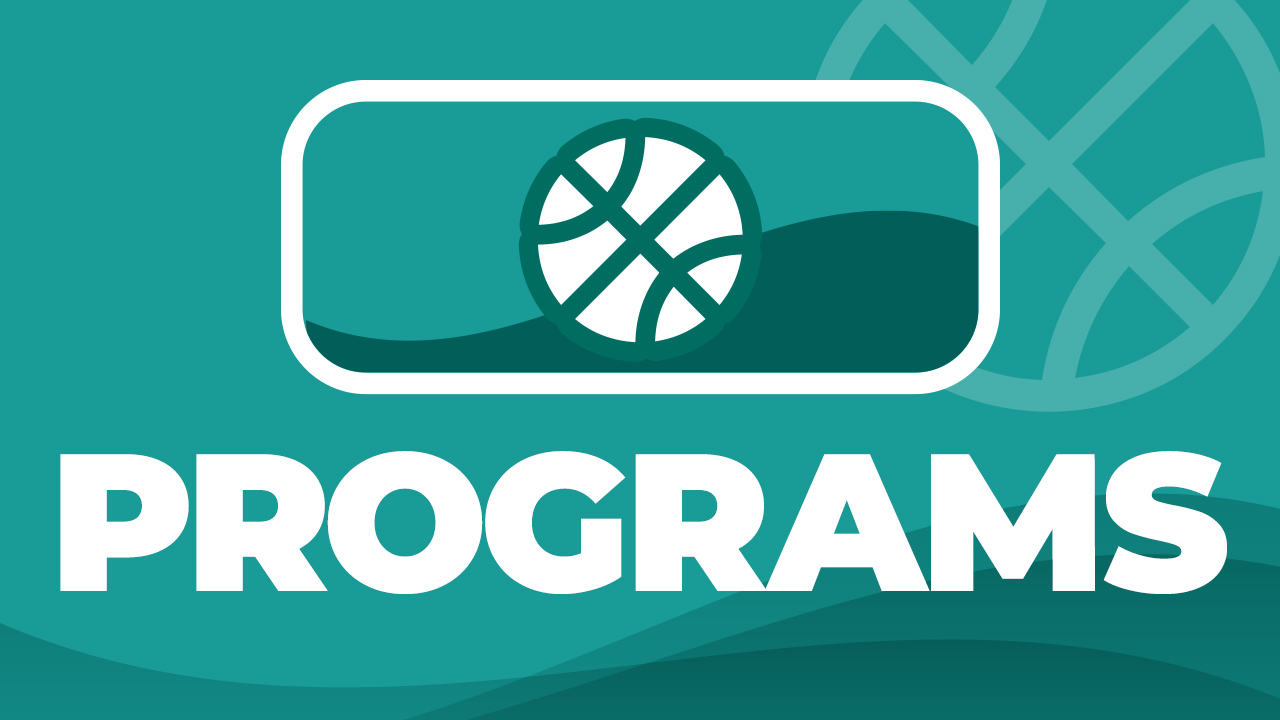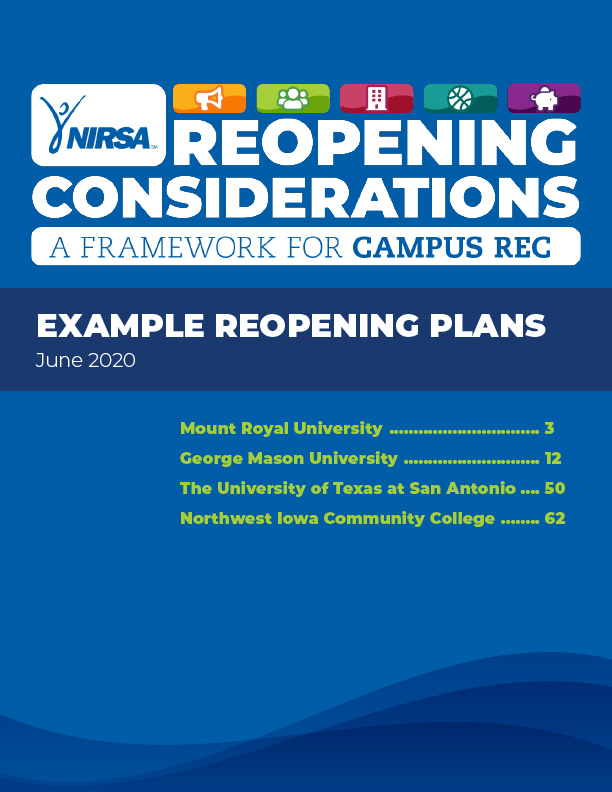Reopening Considerations for Campus Recreation
Programs
The reintroduction of programming activities will be largely dependent upon State or local government guidelines and will be done in conjunction with institutional planning.
Regardless of when distinct programs are reintroduced, a consistent plan for program areas will be essential to the overall success of the reopening plan.
The following considerations have been organized by program area.
Considerations:
- Have you conducted a risk assessment for each sport?
- Consult national governing bodies recommendations for each sport
- Considerations for team sports
- Modify group size
- Reduce participant numbers and or /spaces
- Update equipment cleaning procedures
- Modify equipment-sharing practices
- Adapt cleaning practices to sanitize equipment pre and post competition
- Individual sports
- Update equipment cleaning policies and procedures
- Enhanced individual dual
- Utilize adaptive programming games and competitions
- Extend or expand opportunities for individual sport competitions
Considerations:
- There are different considerations for team sports vs. individual sports.
- Assess recreation and sports programs for their potential for COVID-19 transmission (e.g., individual vs. team sports; high intensity workouts with possible enhanced risk for aerosolization)
- Implement a phased return of sports and recreation programs based upon potential risk of transmission in a given activity
- Consider appropriate restrictions for national competitions-travel
- What modifications might need to be introduced to participant health history screening
- Are squad size limitations necessary
- What is the screening requirement for coaches
- Work-out room capacity modifications – small groups of 10 individuals or fewer, 50 individuals for outdoor spaces etc.
- Encourage social distancing
- Take precautions with shared equipment
- Develop opportunities to compete locally (within a given State) to limit travel
- Modify the role, responsibility, and protocols of Athletic Training services
- Adhere to respective governing body guidelines as it relates to competition, practice, and travel
- Consider that institutional travel guidelines or bans may supersede governing bodies
- Consider clubs on a case-by-case basis (i.e. martial arts).
- Redefine roles and responsibilities of Safety Officers in Club Sports and determine training requirements and communication expectations between and among campus recreation staff and Athletic Training services
- Eliminate or minimize spectators at club sports competitions
- Stagger entry and exit of participants into the facility
- If multiple entry/exit points exist in your facilities, designate one for entry and one for exits in each facility.
- Consider utilizing signage to direct entry and exit traffic into and out of your facility
- Review and modify Emergency Action Plans (EAPs)
- Adjust public signage as well as staff EAPs based on facility operations through the phases of reopening
- For tennis related to sport clubs, follow state and local recreation guidelines as well as USTA guidelines for sport safety and facility and programming recommendations
- Ensure your facility has capacity to isolate suspected cases
- Determine where an individual or group of people can be quarantined, in case of a large number of athletes or event staff being exposed
- Consider alternative sports or engagement opportunities that limit personal contact in particular
- Consider developing an esport model
- Coordinate with intercollegiate athletics
- Consider the limitations of club sports that may not permit reactivating sport competitions
Considerations:
- Consider virtual classes and blend remote and in-person programs
- Alter class schedules to maximize programming
- Consider starting to return slowly to your normal schedule and re-open fitness offerings in phases, starting with private personal training and gradually increasing the number of people (ensure room can accommodate a generously spaced-out configuration that keeps participants at least 10 feet apart) in a live class
- Class duration and capacity will be impacted by spacing considerations
- Online offerings should be maintained at current levels or enhanced when campus recreation returns to normal operations
- Examine the best way to initiate programming in a virtual manner
- Personal and small group fitness training may also be done through a virtual platform
- Provide participants with a space of at least 100 square feet
- Provide markers on the floor to designate the center of a participant’s space
- Stagger rows so there is 12 ft between one marker and the marker in front or behind
- Staggering rows ensures 100 square feet per person
- Stagger entry and exit from room/space where classes are conducted. If there are multiple doors/gates into the space use one for entry and one for exit
- Have staff clean (including floor) and setup equipment in the room prior to a workout
- Provide cleaning supplies in case participants would like to re-clean their equipment
- Have members leave their equipment in place after the workout.
- Have staff clean the equipment, following all protocols and CDC guidelines
- Provide a 15 to 30 minute buffer in between classes to allow for cleaning and sanitation
- Omit fitness classes with high inhalation/exhalation exchange (spin, etc.) until they can be safely incorporated back into class offerings
- For cycling classes, move some of the studio bikes to the back of the studio with seats removed or to another space to ensure proper social distancing in studio cycling classes
Considerations:
- Personal training and small group training could likely continue, with increased awareness and education for the personal training staff and clients on personal space, no spotting permitted, cleaning equipment, etc.
- Personal training recommendations:
- Ten (10) feet will be maintained for personal training between trainer and client. Every effort will be made to schedule sessions when rooms are not heavily occupied or held in specifically designated areas (if available). Trainer will disinfect all equipment prior to and after each class.
- Personal training staff should clean equipment before and after use by their clients. Equipment such as boxing gloves and shadow mittens should only be available for purchase and not loaned by staff. Handles made of soft or absorbent material should not be used. This would include certain cable attachments, suspension equipment, and certain functional training tools.
- Fitness programs should also explore the idea of taking some services to where the students are, such as within residence halls, and other venues where public health and safety standards can be maintained
Considerations:
- Trip leaders should meet participants at location and group transportation to outdoor adventure sites should be curtailed
- Bike share should be limited to reduce daily shares; consider extended duration rentals
- If you plan to offer equipment sharing services, make sure to update your cleaning process upon equipment return; .
- Wash returned equipment as soon as possible
- Consider setting up a space to quarantine outdoor gear until it can be cleaned
- Develop a progression plan for activity implementation
- Masks and PPE should be worn by equipment rental employees; eliminate in-person rentals — phone reservations and payment only
- Online workshops and Lunch and Learns: no large-scale training; utilize online meetings and training when possible
- Outdoor trips should be limited to places that only require local travel and involve fewer than ten people, including staff and only with activities that provide for social distancing
- Video chat options during office hours with equipment rental staff and trip leaders
- Begin temperature checks a day before departure and each day of multi-day trips
- Keep partners paired throughout the trip — i.e. canoe pairs in the same canoe for the duration of trip
- Create food policy – i.e. no sharing food, prepackaged meal requirements, etc.
- Offer virtual hikes during trips for those who can’t attend in-person
- Adjust pricing, since transportation will not be provided
- Front country first aid protocol required (treat and call 911 in case of an emergency)
- All equipment will be properly sanitized and cleaned between use
- Staff will need to be trained on cleaning protocols, physical distancing protocols, what to do with participants who don’t want to wear PPE
Considerations:
- Participant limits should be based on best practices and government guidelines
- Consideration should be given to creating an ‘extended loan’ for shoe rentals to reduce sharing
- Implement cleaning procedures following equipment use
- Determine cleaning procedures for climbing holds
- Training and orientation sessions must adhere to social distancing guidelines
- Create ‘zones’ within climbing spaces to ensure appropriate distancing between participants
- Determine set directional flow of spaces and provide wayfinding support
- Consider implementing a reservation system to control occupancy
- Increase frequency of route setting as a cleaning strategy
- Develop a virtual training program for climbers when the facility or space is not available.
Considerations:
- Calculate participant-per-area and adjust space as required
- Equipment redistribution or closure to ensure social distancing
- Specific recommendations for strength training – no spotting
- Implement ‘traffic flow’ to ensure social distancing
Considerations:
- Examine opportunities to collaborate with Student Health Services, Student Support & Advocacy, Counseling, Disability Support Services, Wellbeing and other relevant units
- Offer educational programming around health, safety, and vitality while living among the COVID-19 environment
- Modify programs to a virtual format
Considerations:
- After a dormant period, thoroughly check and inspect your challenge course and perform necessary maintenance
- Develop and conduct virtual programs if possible
- Do activities that do not require props, or commonly touched materials (like blindfolds), or trust falls or lifting activities
- Reduce the time of offerings to two or three-hour programs
- Manage larger groups by using shifts (e.g. one group arrives at 9:30 and leaves at 12:30 pm and the next arrives at 1:00 and goes until 4:00 pm)
- Arrange for cleaning of equipment, restrooms, and other common spaces between groups
- Hold staff training about how to implement all these requirements, and how to engage dialogues about wearing masks and gloves
- Provide video chats for vulnerable populations
- Minimize use of shared props
Considerations:
- Consider adjustment to acceptable ratios of camper to counselors to ensure guidelines procedures are being followed
- Adapt programming to encourage social distancing and limit shared equipment
- Determining when and if masks are appropriate
- Process for temperature checks and symptom monitoring
- Re-evaluate protocols for when a participant gets sick at camp
- Revise your communication plan with parents to address concerns surrounding COVID-19
- Increase cleaning frequency and ensure supplies are EPA-approved to eliminate COVID-19
- Post additional signage regarding hygiene
- Provide additional hygiene stations and supplies
- Update drop off and pick up protocols
- Increase ventilation for indoor spaces when possible
- Provide thorough staff training on all new protocols
- Consider eliminating activities that require transportation
- Adjust camper “groups” to create “households” to limit exposure
